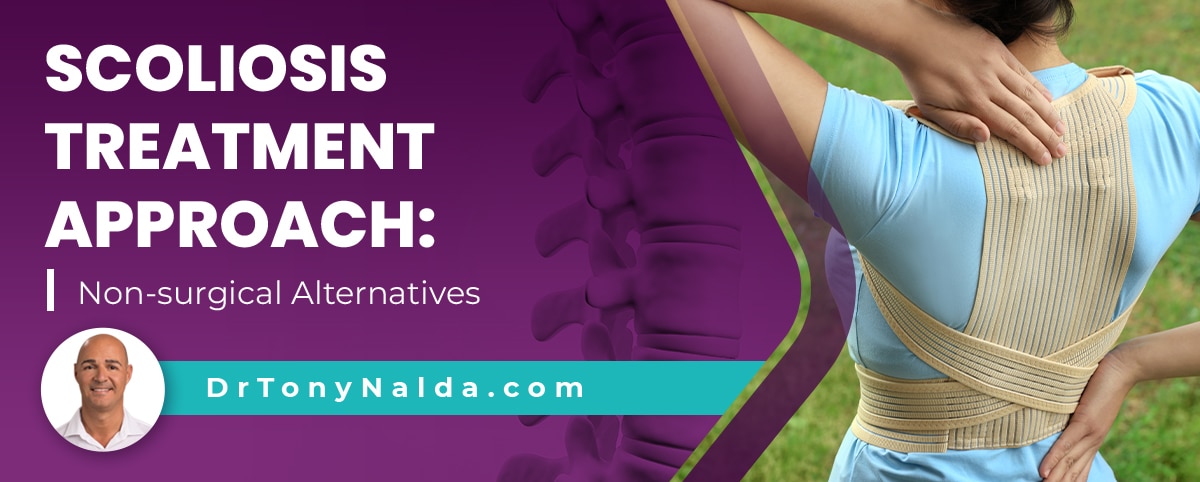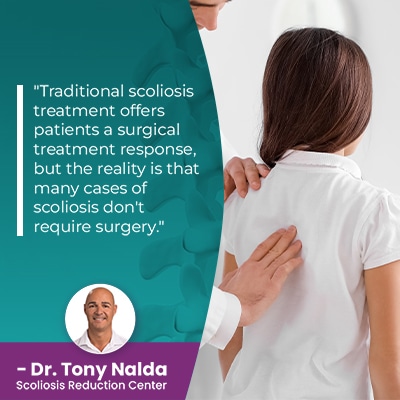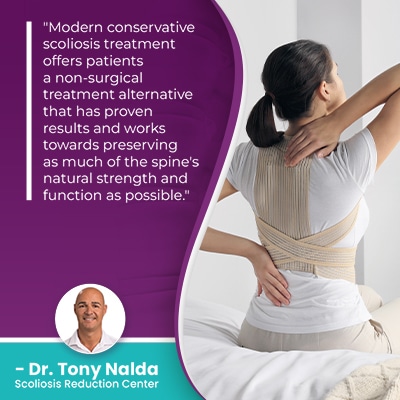Scoliosis Treatment Approach: Non-surgical Alternatives

When someone is diagnosed with scoliosis, the most important decision they have to make is how to treat it moving forward. The decision of how to treat scoliosis can have far-reaching effects; as a progressive spinal condition, but it can be highly treatable, particularly with early detection and a proactive treatment response.
There are different ways to treat scoliosis, and they affect long-term spinal health and function differently. When it comes to a surgical approach, the spine's unlikely to be as strong or flexible after, but a conservative non-surgical treatment approach complements the spine's movement-based design.
A patient's scoliosis journey starts when they receive their diagnosis, so let's start there.
Table of Contents
How is Scoliosis Diagnosed?
There are a number of spinal conditions a person can develop that involve a loss of its healthy curves, but scoliosis is particularly complex because it's highly prevalent, is the leading spinal condition amongst school-aged children, is progressive, and no two cases are the same.
Scoliosis involves the development of an unnatural sideways spinal curve, and its rotation is what makes it a 3-dimensional condition; in addition, the size of the unnatural spinal curve has to be of a minimum size to be considered a true scoliosis.
A minimum Cobb angle measurement of at least 10 degrees is required, and a patient's Cobb angle is determined during X-ray and is also an important benchmark when it comes to crossing the surgical threshold.
The thing about traditional treatment is that little is done prior to progressing into the severe level to prevent progression, and this is because traditional treatment doesn't have a strategy for addressing scoliosis while mild; this is why traditional surgical treatment is commonly described as more reactive than proactive.
With progressive conditions like scoliosis, it's important for patients to understand that sometimes when treatment is started can be almost as important as the type of treatment applied.
Cobb angle measurements are determined during an X-ray by drawing lines from the tops and bottoms of the curve's most-tilted vertebrae, and the resulting angle is expressed in degrees.
The higher a patient's Cobb angle, the further out of alignment the spine is, and the more severe the condition:
- Mild scoliosis: Cobb angle measurement of between 10 and 25 degrees
- Moderate scoliosis: Cobb angle measurement of between 25 and 40 degrees
- Severe scoliosis: Cobb angle measurement of 40+ degrees
- Very-severe scoliosis: Cobb angle measurement of 80+ degrees
For those on the path of traditional treatment, it's when/if a patient's scoliosis progresses into the severe classification at 40+ degrees that they become surgical candidates, so let's now talk about the two main scoliosis treatment approaches.
Scoliosis Treatment Approach
 There are two main scoliosis treatment approaches for patients to choose between: traditional and conservative.
There are two main scoliosis treatment approaches for patients to choose between: traditional and conservative.
Traditional scoliosis treatment offers patients a surgical treatment response, but the reality is that many cases of scoliosis don't require surgery.
Modern conservative scoliosis treatment offers patients a non-surgical treatment alternative that has proven results and works towards preserving as much of the spine's natural strength and function as possible.
Spinal Fusion Surgery
Spinal fusion surgery is an invasive and costly procedure with some serious potential risks, side effects, and complications, so should be considered carefully.
Spinal fusion surgery has the end goal of stopping progression, and this isn't the same as having the goal of actually correcting a scoliosis, which we'll explore more later.
So to stop progression, this means stopping the unnatural spinal curve from getting worse over time, and this involves fusing the curve's most-tilted vertebrae into one solid bone; this is done to eliminate their movement (progression).
The spine consists of vertebrae (bones) stacked on top of one another, and adjacent vertebrae are separated by an intervertebral disc, and these discs are removed between vertebrae being fused, and this is contrary to the spine's natural design and function.
In fact, the intervertebral discs are key spinal structures whose health shapes the health of the entire spine, so removing them is going to impact the spine.
The spinal discs combine forces to facilitate flexibility, they provide cushioning between vertebrae to prevent friction during movement, act as the spine's shock absorbers, and provide the spine with structure (adjacent vertebrae attach to the disc in between).
And once a spine is fused, commonly, rods are attached on either side with pedicle screws to hold it in place, and hardware attached is permanent.
A spine that's fused can be straighter, but it's not going to be as strong, and the main complaint I hear from patients post-spinal fusion is that there is a noticeable loss in spinal flexibility and range of motion that impacts their overall quality of life; this can mean activity restrictions, and the psychological effect of knowing one's spine is weaker and more vulnerable to injury can also cause a lot of fear and hesitation to try new things and/or participate in once-loved activities.
If the fusion is unsuccessful at stopping progression, which it can be, and/or a patient has an adverse reaction to hardware used, or there is a hardware malfunction, the only recourse is more surgery, and the risks only increase with age and with each subsequent procedure.
Risks associated with the procedure itself can include:
- Infection
- Nerve damage
- Excessive blood loss
- Adverse reaction to hardware used
Negative long-term effects associated with the procedure can include:
- A reduced range of spinal flexibility and range of motion
- A spine that's weaker and more vulnerable to injury
- Increased pain at the fusion site
- Activity restrictions due to increased spinal rigidity
The risks of scoliosis surgery are real, so should be considered carefully, and for those wanting to forgo a surgical recommendation or try a less-invasive treatment option first, conservative non-surgical treatment has a number of benefits.
Conservative Non-Surgical Scoliosis Treatment
 Here at the Scoliosis Reduction Center, I specialize in conservative chiropractic scoliosis treatment because I feel this is most aligned with the spine's natural movement-based design and, as such, is going to give patients the best possible quality of life moving forward.
Here at the Scoliosis Reduction Center, I specialize in conservative chiropractic scoliosis treatment because I feel this is most aligned with the spine's natural movement-based design and, as such, is going to give patients the best possible quality of life moving forward.
Non-surgical scoliosis treatment is also known as functional and/or chiropractic-centered, and it involves integrating multiple condition-specific treatment disciplines into treatment plans that can be fully customized to address key patient/condition variables.
As a structural spinal condition, scoliosis has to, first and foremost, be impacted on a structural level, and this is worked towards through chiropractic care that can help realign the spine by reducing the size of the scoliotic curve; this is achieved through a series of chiropractic techniques and manual adjustments.
Once I start to see structural results, I can shift the focus to increasing core strength so the spine's surrounding muscles can optimally support it, and this is worked towards through physical therapy and scoliosis-specific exercises (SSEs) that can also improve posture, address any related muscle imbalance, and stimulate certain areas of the brain for improved brain-body communication.
Corrective bracing is also a regular facet of treatment for adolescent idiopathic scoliosis (the condition's most-prevalent type) as it can be particularly effective on growing spines and can help by pushing the spine into a corrective position.
Rehabilitation can involve continued chiropractic care and a series of custom-prescribed home exercises to further heal and stabilize the spine.
Conclusion
When it comes time for patients to decide on a scoliosis treatment approach to commit to, I want them to be aware of all treatment options available to them, and even more so, I want them to fully understand how the two approaches affect the spine differently.
How strong and functional a spine is will shape a person's quality of life. An unhealthy spine can be painful, weak, is more vulnerable to injury, and is less flexible and functional.
Spinal fusion surgery can address a crooked spine and make it straighter, but the way it's achieved, through artificial means, isn't aligned with the spine's natural design, so the cost can be high.
Conservative chiropractic-centered scoliosis treatment has the priority of preserving as much of the spine's natural strength and function as possible so offers patients a non-invasive surgical treatment alternative with proven results.
Here at the Center, each and every treatment plan is fully customized, and a proactive treatment approach is exactly what progressive conditions like scoliosis need to be met with; it's far more effective to proactively work towards preventing progression than it is to attempt to reverse the effects of progression once they're established.
The best time to start scoliosis treatment is always now, and this is because scoliosis is going to be its most responsive early in its progressive line, when it's milder; progression only makes the spine more rigid and less responsive to treatment, so there is never a good reason to delay treatment.
Dr. Tony Nalda
DOCTOR OF CHIROPRACTIC
After receiving an undergraduate degree in psychology and his Doctorate of Chiropractic from Life University, Dr. Nalda settled in Celebration, Florida and proceeded to build one of Central Florida’s most successful chiropractic clinics.
His experience with patients suffering from scoliosis, and the confusion and frustration they faced, led him to seek a specialty in scoliosis care. In 2006 he completed his Intensive Care Certification from CLEAR Institute, a leading scoliosis educational and certification center.
About Dr. Tony Nalda
 Ready to explore scoliosis treatment? Contact Us Now
Ready to explore scoliosis treatment? Contact Us Now





